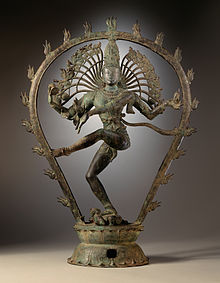| Natya Shastra | |
|---|---|
 | |
| Information | |
| Religion | Hinduism |
| Author | Bharata Muni |
| Language | Sanskrit |
| Part of a series on |
| Hindu scriptures and texts |
|---|
 |
| Related Hindu texts |
| Part of a series on |
| Hinduism |
|---|
 |
The Nāṭya Shāstra (Sanskrit: नाट्य शास्त्र, Nāṭyaśāstra) is a Sanskrit treatise on the performing arts.[1][2] The text is attributed to sage Bharata, and its first complete compilation is dated to between 200 BCE and 200 CE,[3][4] but estimates vary between 500 BCE and 500 CE.[5]
The text consists of 36 chapters with a cumulative total of 6000 poetic verses describing performance arts. The subjects covered by the treatise include dramatic composition, structure of a play and the construction of a stage to host it, genres of acting, body movements, make up and costumes, role and goals of an art director, the musical scales, musical instruments and the integration of music with art performance.[6][7]

The Nāṭya Śāstra is notable as an ancient encyclopedic treatise on the arts,[2][8] one which has influenced dance, music and literary traditions in India.[9] It is also notable for its aesthetic "Rasa" theory, which asserts that entertainment is a desired effect of performance arts but not the primary goal, and that the primary goal is to transport the individual in the audience into another parallel reality, full of wonder, where they experience the essence of their own consciousness, and reflect on spiritual and moral questions.[8][10] The text further inspired secondary literature such as the 10th century commentary Abhinavabharati – an example of a classic Sanskrit bhasya ("reviews and commentaries") – written by Abhinavagupta.[11]
- ^ Katherine Young; Arvind Sharma (2004). Her Voice, Her Faith: Women Speak on World Religions. Westview Press. pp. 20–21. ISBN 978-0-8133-4666-3.
- ^ a b Guy L. Beck (2012). Sonic Liturgy: Ritual and Music in Hindu Tradition. University of South Carolina Press. pp. 138–139. ISBN 978-1-61117-108-2.
Quote: "A summation of the signal importance of the Natyashastra for Hindu religion and culture has been provided by Susan Schwartz, "In short, the Natyashastra is an exhaustive encyclopedic dissertation of the arts, with an emphasis on performing arts as its central feature. It is also full of invocations to deities, acknowledging the divine origins of the arts and the central role of performance arts in achieving divine goals (…)".
- ^ Natalia Lidova 2014.
- ^ Tarla Mehta 1995, pp. xxiv, 19–20.
- ^ Wallace Dace 1963, p. 249.
- ^ Sreenath Nair 2015.
- ^ Emmie Te Nijenhuis 1974, pp. 3–4, 7–25.
- ^ a b Cite error: The named reference
Schwartz2004p12was invoked but never defined (see the help page). - ^ Sunil Kothari & Avinash Pasricha 2001, p. 117, 163.
- ^ Daniel Meyer-Dinkgräfe (2005). Approaches to Acting: Past and Present. Bloomsbury Academic. pp. 102–104, 155–156. ISBN 978-1-4411-0381-9.
- ^ Ananda Lal 2004, p. 308.